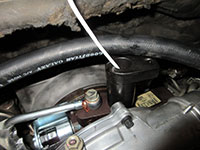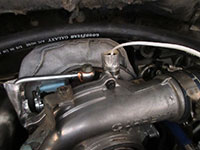The vane position sensor perpetually measures the position of the unison ring and thus the angular position of the VGT vanes inside the turbocharger turbine housing. The indicator on the nose of the sensor rides on an eccentric camshaft lobe integrated into the unison ring position armature. As the position of the armature changes, the indicator on the vane position sensor rises or falls on the cam lobe; the reading of the vane position sensor will change with these movements. This information is used by the ECM to control the VGT solenoid, which is ultimately the hydraulic control unit of the entire process and physical moves the unison ring/vanes via engine oil pressure.
The vane position sensor receives a 5 volt reference signal from the ECM. The return voltage varies with the position of the sensor indicator; voltage will decrease when the vanes are opening and reach the lowest value when the vanes are fully open. Voltage will increase when the vanes are closing and reach the highest value when the vanes are fully closed. A faulty vane position sensor may result in the ECM actuating the VGT solenoid (sometimes also referenced as the vane position solenoid or vane position valve) incorrectly based on the current engine demand. Poor response, excessive turbo lag, and reduced power may be symptoms of a faulty vane position sensor and/or VGT solenoid.
Recalibrating the Vane Position Sensor
After replacing the vane position sensor, the ECM must recalibrate or "remap" to the new sensor signal. The remap process generally occurs automatically after normal driving; depending on how the vehicle is used, it may take up to several hundred miles to complete this step, although it generally occurs in much less time. If DTCs P003A and/or P2563 are set after replacing the vane position sensor, it is highly likely that the ECM did not calibrate the new sensor correctly. In this event, a scan tool can be used to force the recalibration process. Although instructions will vary slightly depending on the scan tool, you'll need to locate the "TC learn output" function and command the TC vane position sensor "ON" for a minimum of 5 seconds, then return to "OFF" before exiting. If you subsequently locate the "TC Learned" parameter ID (PID), it should have toggled from "NO" to "YES". The following conditions must be met before initiating this process:
• Engine coolant temperature is at least 104° F.
• Air conditioner is turned off
• Transmission is in the park (automatic) or neutral (manual) position
• Engine is idling and the accelerator pedal is NOT depressed
Again, the process will vary slightly depending on the model of scan tool used; not all scan tools will support this function. If the vane position sensor continuously fails to calibrate, the unison ring or vanes may be mechanically stuck and further diagnostics are necessary to determine why there is no movement in the system.
How to Replace the Vane Position Sensor
Click any thumbnail to view fullsize, detailed image
• Locate the vane position sensor atop the turbocharger center section to the driver side of the turbo oil feed line.
• Trace the VPS wire to the electrical connector and disconnect it.
• Snake the electrical connector through the wiring harness and any brackets in its way (it's quite a maze). The wire can also be cut since it is being replaced.
• Remove the heat shield wrap from the vane position sensor by cutting the clamp and peeling it off.
• Remove the VPS from the turbocharger using an appropriate socket (such as Schley SCH12400).
• Ensure that the mating surface is clean of any debris to avoid infiltration into the turbocharger oil supply.
• Install the replacement vane position sensor, maneuvering the wire as the socket is rotated as not to kink, break, or entangle the connector/wire.
• Torque sensor to 21 lb-ft.
• Install the included heat shield onto the new vane position sensor. A typically hose clamp can be used as a substitute to the included crimp clamp so that the heat shield can be removed and reinstalled in the future.
• Reinstall the intake resonator and reconnect both negative battery cables.
• Start engine and test for proper operation. If a scan tool is being used to recalibrate the sensor, follow the manufacturer's procedures. The system will remap naturally through normally driving, thus this is not generally required.







